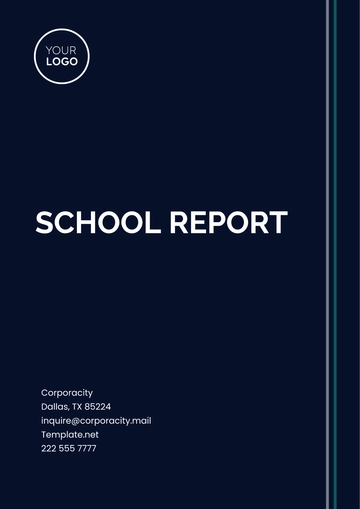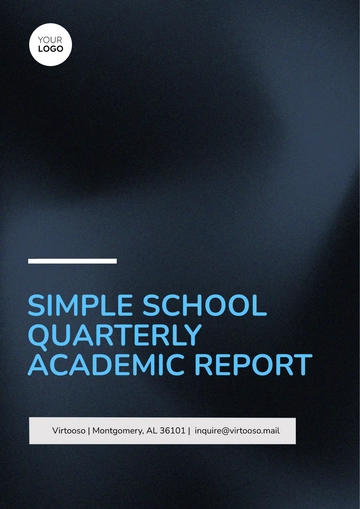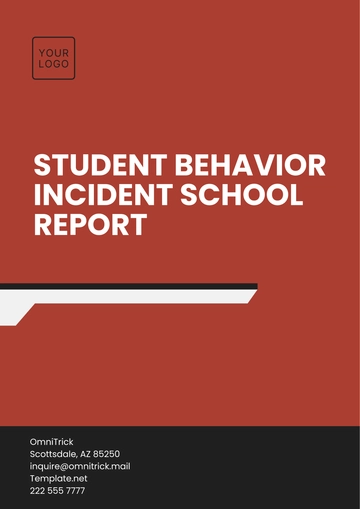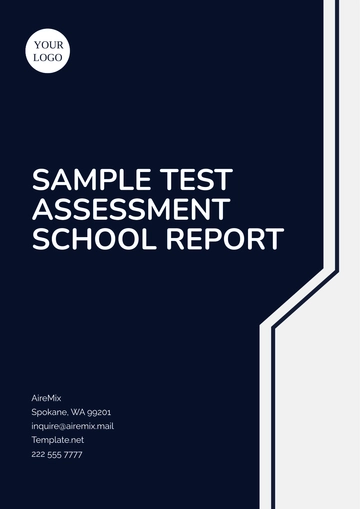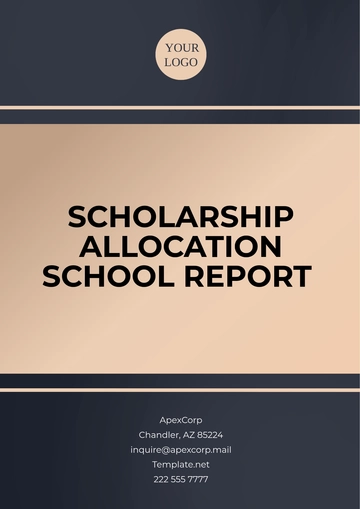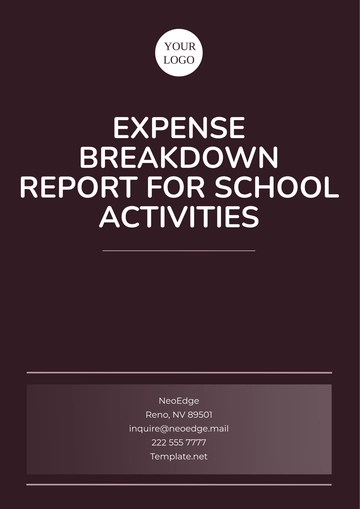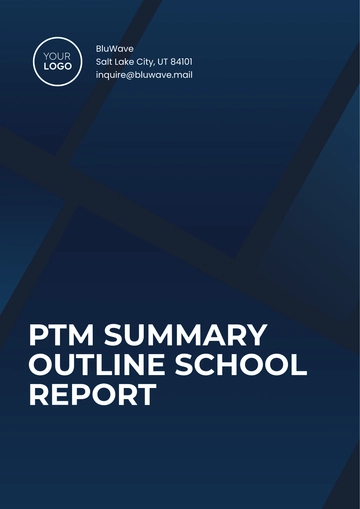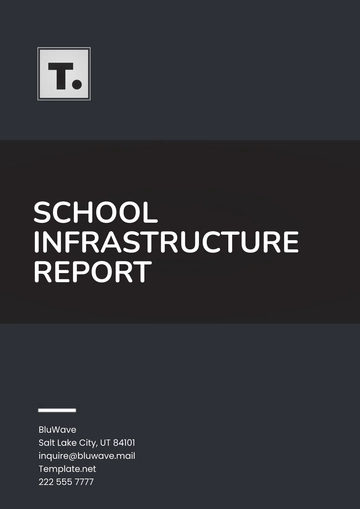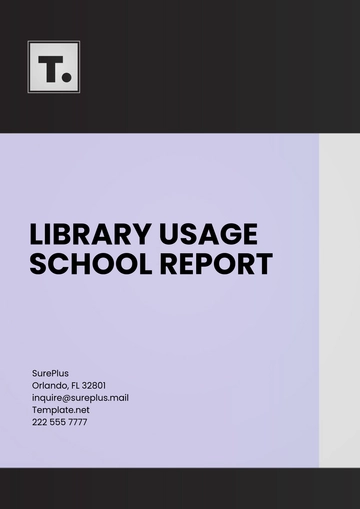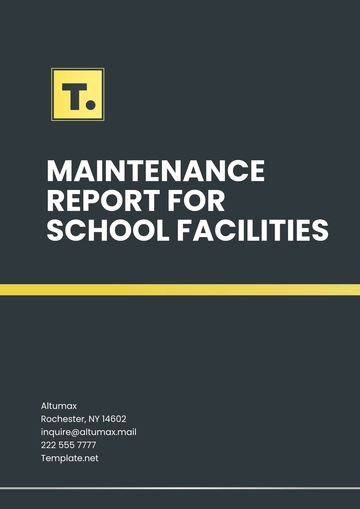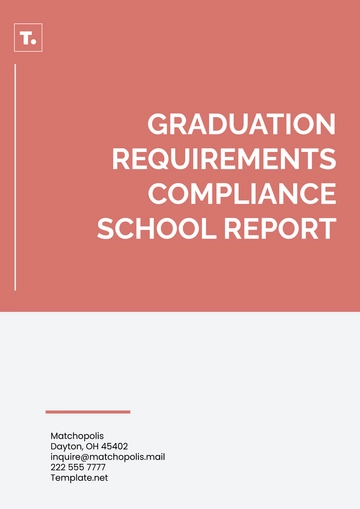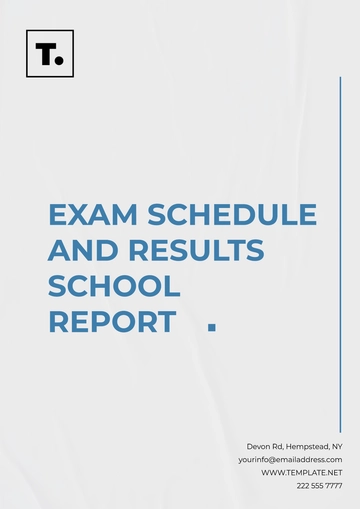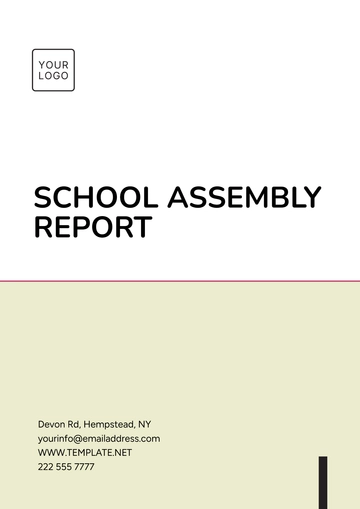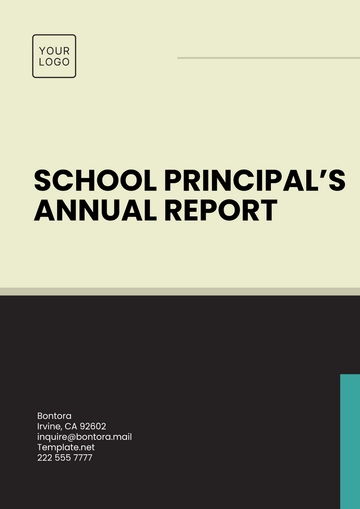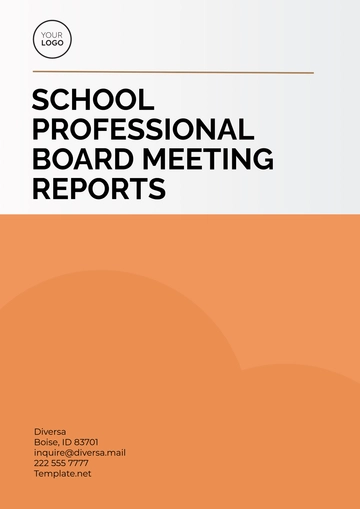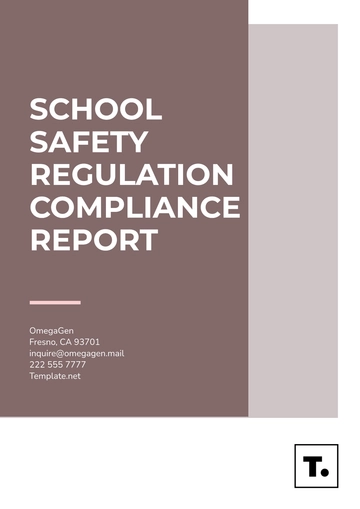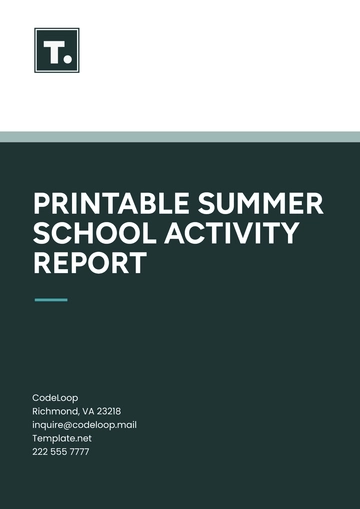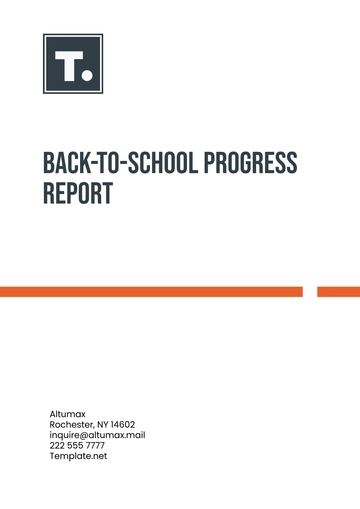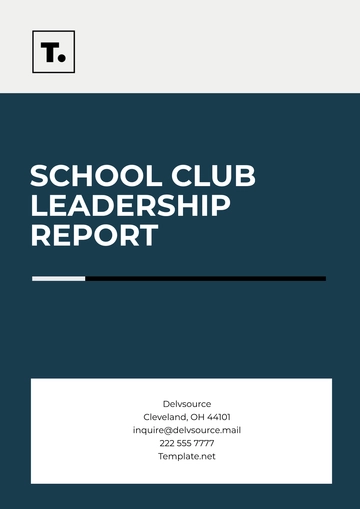Free Kindergarten Attendance Report
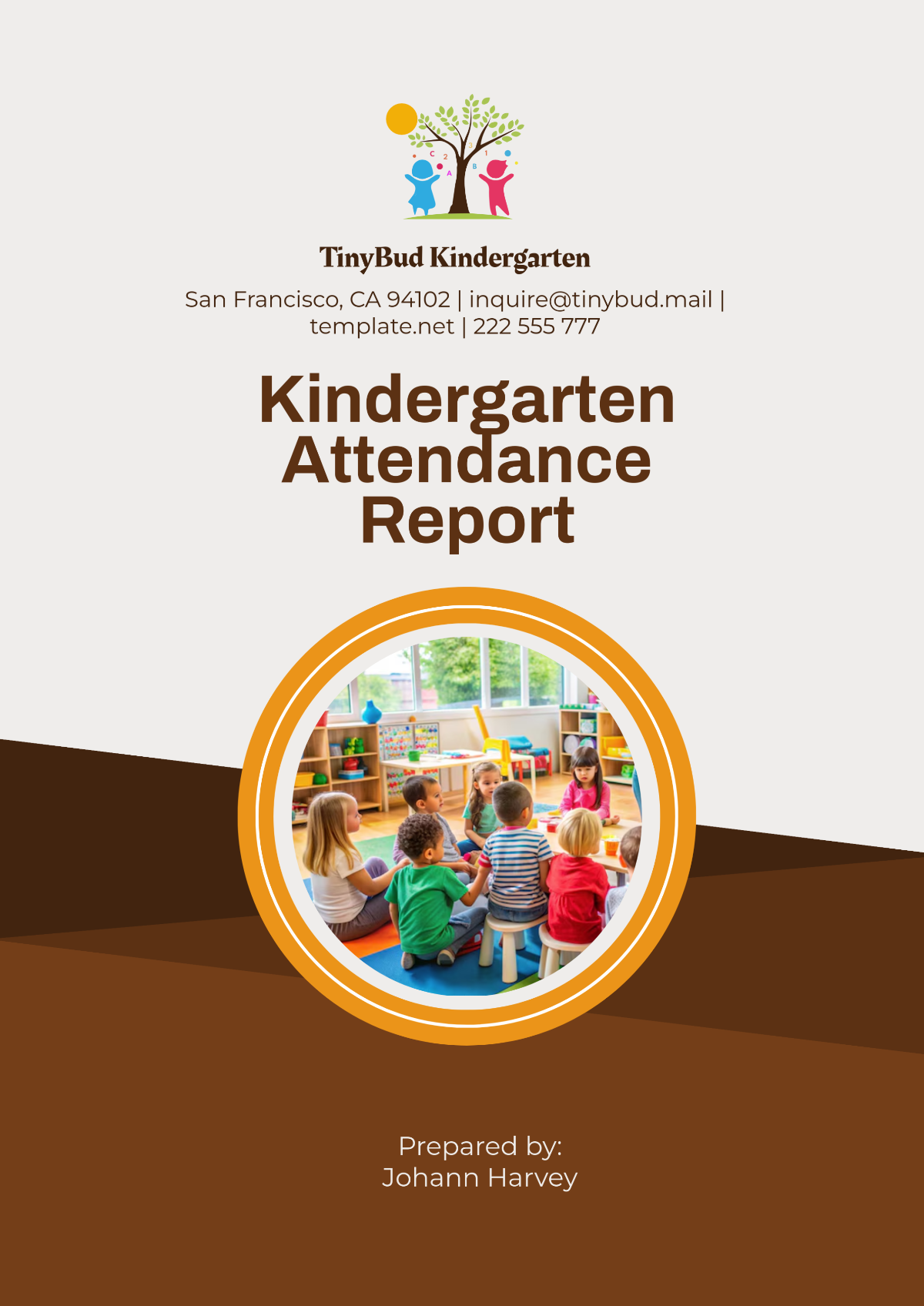
Year: 2050
Institution: [Your Company Name]
Executive Summary
This comprehensive report analyzes kindergarten attendance data for the academic year 2050 at [Your Company Name]. The analysis presents trends, patterns, and insights on the main factors influencing attendance, the reasons for absences, and the economic and social impact of absenteeism. In addition, it offers actionable recommendations to improve attendance and minimize disruptions to the educational process.
Key findings from the analysis are as follows:
Overall Attendance Rate: [92.3%], which represents a solid foundation, though there is room for improvement.
Peak Attendance Month: October, with the highest recorded attendance of [96.5%].
Most Common Reason for Absences: Illnesses such as colds, flu, and stomach viruses accounted for [48.7%] of all absences.
Economic Impact of Absences: The loss in funding due to reduced attendance is estimated to be around $[12,500].
The report emphasizes the importance of health interventions, better parental engagement, and efficient use of technology to track attendance. Addressing the root causes of absenteeism can substantially improve attendance rates and ensure more consistent educational experiences for students.
1. Introduction
1.1 Purpose of the Report
The primary purpose of this report is to analyze the kindergarten attendance data from the academic year 2050 at [Your Company Name]. The analysis aims to provide insights into the attendance trends of students, assess the impact of absenteeism on student outcomes, and identify strategies to improve overall attendance.
It is widely recognized that consistent school attendance in the early years of education is a crucial factor in shaping a child's educational experience. The learning gaps created by frequent absences can have long-term consequences on a child's academic and developmental progress. Therefore, understanding and addressing the causes of absenteeism is vital for improving student outcomes and ensuring that all children receive a quality education.
The data presented in this report covers attendance records from January through December 2050, with a focus on identifying trends related to health, socioeconomic factors, and environmental issues that affect student attendance. In doing so, this report serves as a valuable resource for both school administrators and policymakers in creating targeted interventions for the future.
1.2 Methodology
This report uses a combination of quantitative and qualitative data to provide a comprehensive analysis of attendance patterns. The primary source of data is the daily digital attendance logs maintained by [Your Company Name], which track the attendance of each student along with the reasons for absences.
To ensure the validity of the data, a variety of secondary sources were also consulted. These include parental surveys, feedback from teachers, and medical records where available. In addition, attendance trends were analyzed in the context of seasonal factors (such as flu season) and external influences, such as weather disruptions or economic conditions that may have influenced parents' ability to send their children to school.
The data was processed and analyzed using advanced statistical techniques to identify patterns and correlations. These findings were then presented in both tabular and graphical formats for clarity. Qualitative insights, including parental feedback and teacher observations, were used to supplement the quantitative data and provide a fuller understanding of the factors influencing attendance.
2. Attendance Data Overview
2.1 Attendance Rates by Month
The monthly attendance data for the academic year 2050 is presented below in Table 1. The table shows attendance rates for each month, as well as the corresponding number of students present and the number of absences recorded.
Table 1: Monthly Attendance Rates
Month | Attendance Rate (%) | Number of Students Present | Number of Absences |
|---|---|---|---|
January | 90.1 | 451 | 49 |
February | 91.7 | 459 | 41 |
March | 92.8 | 464 | 36 |
April | 94.0 | 470 | 30 |
May | 93.5 | 467 | 33 |
June | 93.7 | 468 | 32 |
The highest attendance rates were recorded in April ([94.0%]), while the lowest attendance rate was observed in January ([90.1%]), likely due to the seasonal flu and post-holiday recovery. These trends indicate that health-related issues, particularly illnesses, have a significant impact on student attendance.
2.2 Annual Attendance Statistics
For the year 2050, the overall attendance rate across all months was calculated to be [92.3%]. This figure is slightly above the national average of [90%], indicating a generally high level of student attendance at [Your Company Name].
Overall Attendance Rate: [92.3%]
Average Daily Attendance: [468 students]
Total School Days: [200 days]
Total Absences Recorded: [550 absences]
The average number of students attending on a daily basis is [468], reflecting the institution's consistent attendance rate across the year. While the total number of absences may seem high, it is important to note that many of these absences were excused due to illness or other legitimate reasons.
3. Attendance Analysis
3.1 Factors Influencing Attendance
3.1.1 Health-Related Issues
Health-related issues are the primary cause of absenteeism in the kindergarten population at [Your Company Name]. The most common illnesses that result in absences include colds, flu, stomach viruses, and seasonal respiratory illnesses. These health problems account for approximately [48.7%] of all absences. The peak of these illnesses usually occurs during the winter months (January to March), which aligns with the lower attendance rates during those months.
In particular, the flu season had a major impact on attendance in the early months of the year. Many children were unable to attend school due to high fever, fatigue, and other flu-related symptoms. A targeted health intervention, such as providing flu vaccinations to all students, could potentially reduce the number of absences caused by seasonal illnesses.
Additionally, health-related absences are often linked to family members being unwell, as parents may need to stay home to care for their children. Thus, improving the overall health of the student body and their families would likely have a direct positive impact on attendance.
3.1.2 Socioeconomic Factors
Socioeconomic status plays a significant role in student attendance. Families with lower household incomes are more likely to experience challenges such as inadequate access to healthcare, unstable housing, and transportation issues. These factors can contribute to higher absenteeism rates.
For example, students from families earning below $[25,000] per year reported [25%] higher absence rates compared to their peers. These students were more likely to miss school due to factors such as lack of access to proper healthcare, difficulty in obtaining transportation, or the need for older siblings to stay home and care for younger children.
The institution could consider offering targeted support for low-income families, such as providing transportation assistance or access to health resources, to help reduce attendance gaps among students from lower socioeconomic backgrounds.
3.1.3 Weather and Natural Disruptions
Weather conditions, particularly extreme events such as heavy rain or floods, also have a notable impact on student attendance. On days with severe weather, attendance typically dips by approximately [18%]. In areas prone to flooding, students living in low-lying regions often face difficulty reaching the school.
Additionally, during the summer months, particularly in the months of May through August, hot weather can make it difficult for families to maintain regular attendance, especially if schools lack air-conditioning or other cooling facilities. Weather-related disruptions, while often beyond the institution’s control, should be considered when analyzing trends in absenteeism.
3.2 Seasonal Trends
Attendance patterns tend to vary throughout the year due to factors such as weather, holidays, and illness. A key observation from the data is that attendance rates are generally lower at the beginning and end of the academic year, which is consistent with national trends for kindergarten students.
The highest attendance rate was recorded in October ([96.5%]), likely due to students adjusting to the routine after the long summer break and the absence of major illnesses. In contrast, attendance rates were lowest in January ([90.1%]), reflecting the flu season and the post-holiday fatigue that can affect both children and parents.
3.3 Absence Patterns
A breakdown of the main reasons for student absences is shown in Table 2. The table categorizes absences by reason, with the percentage of total absences attributed to each cause.
Table 2: Absence Breakdown by Reason
Reason for Absence | Percentage of Total Absences |
|---|---|
Illness (Cold, Flu, etc.) | 48.7% |
Family Emergency | 16.5% |
Transportation Issues | 10.4% |
Vacation/Travel | 8.9% |
Weather-related Absences | 8.3% |
Other (e.g., appointments) | 7.2% |
The most common reason for absenteeism was illness (cold, flu, etc.), accounting for almost half of all absences. Family emergencies also contributed significantly to the absence rate, especially during periods of personal loss or other urgent situations that required immediate attention.
4. Economic Impact of Absenteeism
4.1 Loss of Funding
One of the key economic consequences of absenteeism is the loss of government funding. Many education systems are funded based on student attendance, and absences can directly affect the financial resources available to the institution. At [Your Company Name], each absence results in a financial loss of approximately $[25] per day per student, which accumulates quickly over the course of a year.
The total estimated loss in funding due to absenteeism in 2050 is around $[12,500]. This figure represents a potential reduction in resources that could be better allocated toward improving educational outcomes, purchasing classroom materials, or funding extracurricular activities.
4.2 Cost of Lost Learning
In addition to the financial impact, absenteeism can also lead to a loss in the quality of learning. Students who miss school frequently are less likely to stay on track with their peers academically, which can lead to learning gaps and delays in skill acquisition. This can affect their overall educational trajectory, leading to long-term challenges in terms of academic performance and confidence.
A focus on improving attendance can help mitigate these challenges, ensuring that students receive a more consistent and quality education.
5. Recommendations
5.1 Health Interventions
Given the high percentage of absences due to illness, a proactive approach to student health is essential. Schools can collaborate with local healthcare providers to implement health programs that focus on preventing illnesses that lead to absenteeism. This could include:
Flu Vaccinations: Organizing annual flu vaccination drives to reduce the number of students falling ill during flu season.
Health Checkups: Offering routine health screenings to catch early signs of illness, such as vision or hearing problems, that might contribute to absences.
Hand Hygiene and Hygiene Education: Initiating programs to teach students about proper handwashing techniques and the importance of hygiene to reduce the spread of contagious illnesses.
These initiatives would not only reduce the number of health-related absences but also foster a healthier school environment.
5.2 Parental Engagement and Support
Engaging parents and providing them with the resources they need to support their children's education can play a key role in reducing absenteeism. Schools can take the following actions to improve parental engagement:
Communication Platforms: Developing and maintaining a system to keep parents informed about their child's attendance and any issues related to absenteeism. Regular updates via email, SMS, or a school app can remind parents of the importance of regular attendance and alert them to any attendance problems.
Socioeconomic Support: Recognizing that some families face barriers such as transportation or financial constraints, schools could offer resources to help alleviate these challenges. This could include:
Providing transportation assistance for students who have trouble getting to school.
Offering support programs for families who struggle with meeting basic needs, which might affect a child’s ability to attend school regularly.
Workshops and Educational Sessions for Parents: Hosting workshops to educate parents about the value of consistent attendance and its impact on academic performance and overall well-being.
5.3 Technology for Attendance Monitoring
Leveraging technology can help track absenteeism patterns more efficiently and intervene earlier. Schools should consider implementing the following:
Digital Attendance Systems: Adopting automated attendance tracking systems that provide real-time data on student absences, making it easier to identify trends and patterns early.
Notifications and Alerts: Setting up an automated system that notifies parents when their child has missed a certain number of days, encouraging timely intervention.
Data Analytics: Using data analytics tools to identify the root causes of absenteeism—whether it’s due to illness, transportation issues, or other factors—allowing for targeted interventions that address the specific reasons behind the absences.
5.4 Strengthening Community Partnerships
A strong partnership with the local community can further support efforts to reduce absenteeism. Schools can collaborate with local organizations to provide additional resources:
Community Health Initiatives: Partnering with local health providers to offer free or low-cost medical services for students, including vaccinations, checkups, and mental health support.
Mentorship Programs: Establishing mentorship programs where community members or older students act as role models, encouraging younger students to attend school regularly.
Support for At-Risk Students: Identifying students at risk of chronic absenteeism and providing them with dedicated support, such as counseling, academic tutoring, or access to food and clothing assistance.
5.5 Flexible Learning Options
For students who may struggle with attending school due to illness, family responsibilities, or other challenges, offering flexible learning options can help them stay engaged in their education without falling behind:
Virtual Learning: Implementing virtual learning options for students who need to miss school for extended periods due to illness or family emergencies.
Homework and Catch-Up Programs: Establishing a homework support program that allows students who miss school to catch up on lessons without falling behind academically.
Hybrid Learning Models: For students with long-term health issues, offering hybrid learning models can allow them to access their lessons from home while maintaining a connection to the classroom.
5.6 Early Intervention and Counseling Services
Students who miss school frequently might be facing issues beyond physical illness, such as anxiety, bullying, or academic struggles. Establishing an early intervention system with access to counseling services can help address the underlying causes of absenteeism. This could include:
On-Site Counseling: Providing access to a counselor who can help students work through issues such as anxiety or depression that might prevent them from attending school regularly.
Peer Support Programs: Creating peer support networks that allow students to talk to their peers about issues they’re facing, which may help alleviate feelings of isolation or anxiety.
Early Warning Systems: Setting up a system that flags students who exhibit signs of chronic absenteeism and provides them with timely support to address the root causes.
5.7 Incentives for Good Attendance
Positive reinforcement can encourage students to attend school regularly. Schools can implement incentive programs that reward students for good attendance, such as:
Attendance Rewards: Offering rewards such as certificates, free time, or small prizes for students who maintain a certain level of attendance over the course of a term.
Classroom Competitions: Creating friendly competition between classes or grade levels to see which group has the best attendance, with rewards for the winning class or grade.
Recognition: Publicly recognizing students who have improved their attendance, either through announcements, newsletters, or award ceremonies, to highlight the importance of regular school attendance.
5.8 Enhancing School Environment
A welcoming and positive school environment can make students feel more comfortable and eager to attend school. Improving the overall environment can reduce absenteeism related to issues such as school-related anxiety, bullying, or lack of engagement:
Anti-Bullying Programs: Implementing school-wide anti-bullying programs to create a safe and supportive environment for all students.
Inclusive Activities: Offering a variety of extracurricular activities to engage students and make school a place where they want to be, such as sports, clubs, arts programs, or academic competitions.
Student Leadership Opportunities: Giving students leadership roles in school activities, such as being part of a student council or event planning committee, to foster a sense of ownership and pride in their school.
5.9 Policy Changes
To further address absenteeism, schools may need to revise policies related to attendance. These changes could include:
Excused Absence Policies: Re-evaluating policies surrounding excused absences to ensure they are not overly strict and that they accommodate students who miss school due to legitimate reasons such as illness or family emergencies.
Long-Term Absence Plans: Developing specific policies for students who face extended absences due to medical reasons, providing a clear plan for how they can catch up on schoolwork and re-integrate into the classroom.
Flexible School Hours: Considering flexibility in school start and end times for students who face difficulties with early morning transportation or other challenges.
5.10 Addressing Mental Health
Finally, addressing the mental health of students is critical in reducing absenteeism, especially among older students who may be dealing with pressures related to schoolwork, family expectations, or peer relationships. Schools should:
Promote Mental Health Awareness: Conduct awareness campaigns that normalize conversations about mental health and encourage students to seek help when needed.
Stress Management Programs: Implement stress management programs to help students cope with the pressures of school life, exams, and social expectations.
Supportive Counseling Services: Providing easy access to mental health professionals who can support students struggling with mental health issues, from anxiety to more severe conditions.
6. Additional Analysis (To Be Developed in Future Reports)
Future analysis should focus on tracking the progress of these recommendations and their impact on absenteeism rates. Regular data collection, feedback from parents and teachers, and student surveys can provide valuable insights into how well these interventions are working and where further adjustments are needed.
- 100% Customizable, free editor
- Access 1 Million+ Templates, photo’s & graphics
- Download or share as a template
- Click and replace photos, graphics, text, backgrounds
- Resize, crop, AI write & more
- Access advanced editor
Track daily attendance efficiently with the Kindergarten Attendance Report Template from Template.net. Editable and customizable via our AI Editor Tool, this template helps teachers maintain accurate records for compliance and parent communication.
You may also like
- Sales Report
- Daily Report
- Project Report
- Business Report
- Weekly Report
- Incident Report
- Annual Report
- Report Layout
- Report Design
- Progress Report
- Marketing Report
- Company Report
- Monthly Report
- Audit Report
- Status Report
- School Report
- Reports Hr
- Management Report
- Project Status Report
- Handover Report
- Health And Safety Report
- Restaurant Report
- Construction Report
- Research Report
- Evaluation Report
- Investigation Report
- Employee Report
- Advertising Report
- Weekly Status Report
- Project Management Report
- Finance Report
- Service Report
- Technical Report
- Meeting Report
- Quarterly Report
- Inspection Report
- Medical Report
- Test Report
- Summary Report
- Inventory Report
- Valuation Report
- Operations Report
- Payroll Report
- Training Report
- Job Report
- Case Report
- Performance Report
- Board Report
- Internal Audit Report
- Student Report
- Monthly Management Report
- Small Business Report
- Accident Report
- Call Center Report
- Activity Report
- IT and Software Report
- Internship Report
- Visit Report
- Product Report
- Book Report
- Property Report
- Recruitment Report
- University Report
- Event Report
- SEO Report
- Conference Report
- Narrative Report
- Nursing Home Report
- Preschool Report
- Call Report
- Customer Report
- Employee Incident Report
- Accomplishment Report
- Social Media Report
- Work From Home Report
- Security Report
- Damage Report
- Quality Report
- Internal Report
- Nurse Report
- Real Estate Report
- Hotel Report
- Equipment Report
- Credit Report
- Field Report
- Non Profit Report
- Maintenance Report
- News Report
- Survey Report
- Executive Report
- Law Firm Report
- Advertising Agency Report
- Interior Design Report
- Travel Agency Report
- Stock Report
- Salon Report
- Bug Report
- Workplace Report
- Action Report
- Investor Report
- Cleaning Services Report
- Consulting Report
- Freelancer Report
- Site Visit Report
- Trip Report
- Classroom Observation Report
- Vehicle Report
- Final Report
- Software Report
